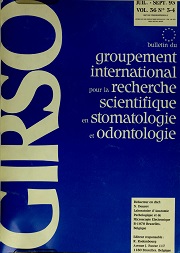Morphometric analysis of mandibular canal: clinical aspects
Keywords:
mandibular canal, morphometric analysisAbstract
Results of morphometric analysis of the mandibular canal (MC), carried out on 105 conserved mandibles, 70 being dentate and 35 edentate, was performed. The analysis was carried out on consecutive sections, at mutual intervals of 0.5 cm. In the mandibular ramus sections were carried out obliquely, approximately in the frontal plane, and horizontally, from mandibular foramen to the lowest region of the vertical part of the MC (all together two sections). In the mandibular corpus, consecutive transversal sections were carried out between existing teeth, or at mutual intervals of 0.5 cm in edentate regions.
The obtained results pointed out the very close relationship between the MC and lingual cortical plate of the mandibular ramus. In its horizontal part, the average diameter of the MC was 2.6 mm. It was situated more lingually in the molar region; towards the front, it approached the vestibular cortical plate, being closest to it in the region of the second premolar. Similar relationships of the MC and both cortical plates existed in edentate jaws. Relationships of the MC and tooth root apices varied; however, the MC was closest to the apices of the third molar. Mesially from the mental foramen, a clearly defined incisive canal was present in 92% of the dentale mandibles, but only in 31% of the edentate ones. The nearest to the incisive canal was the apex of the first premolar.
The authors point out the importance of presented results in everyday practice, especially in oral and maxillofacial surgery. Having in mind the existing relationship between the MC and neighbouring structures, it is possible to avoid the injury of its content during several oral surgical procedures in mandibular ramus and corpus.
Downloads
Published
Issue
Section
License
I hereby certify that the authors of the above manuscript have all:
1. Conceived, planned, and performed the work leading to the report, or interpreted the evidence presented, or both;
2. Written the report or reviewed successive versions and shared in their revisions; and
3. Approved the final version.
Further, I certify that:
1. This work has not been published elsewhere and is not under revision in another journal;
2. Humane procedures have been followed in the treatment of experimental animals (if applicable);
3. Investigations in humans was done in accordance with the ethical standards of the responsible committee on human experimentation or with the Helsinki Declaration (if applicable).
4. This paper has been carefully read by a native English speaker who is familiar with the field of work (this applies to authors who are not fluent in English); and
5. The copyright of the article is transferred from the authors to the Bulletin du Groupement International pour la Recherche Scientifique en Stomatologie et Odontologie upon acceptance of the manuscript.



